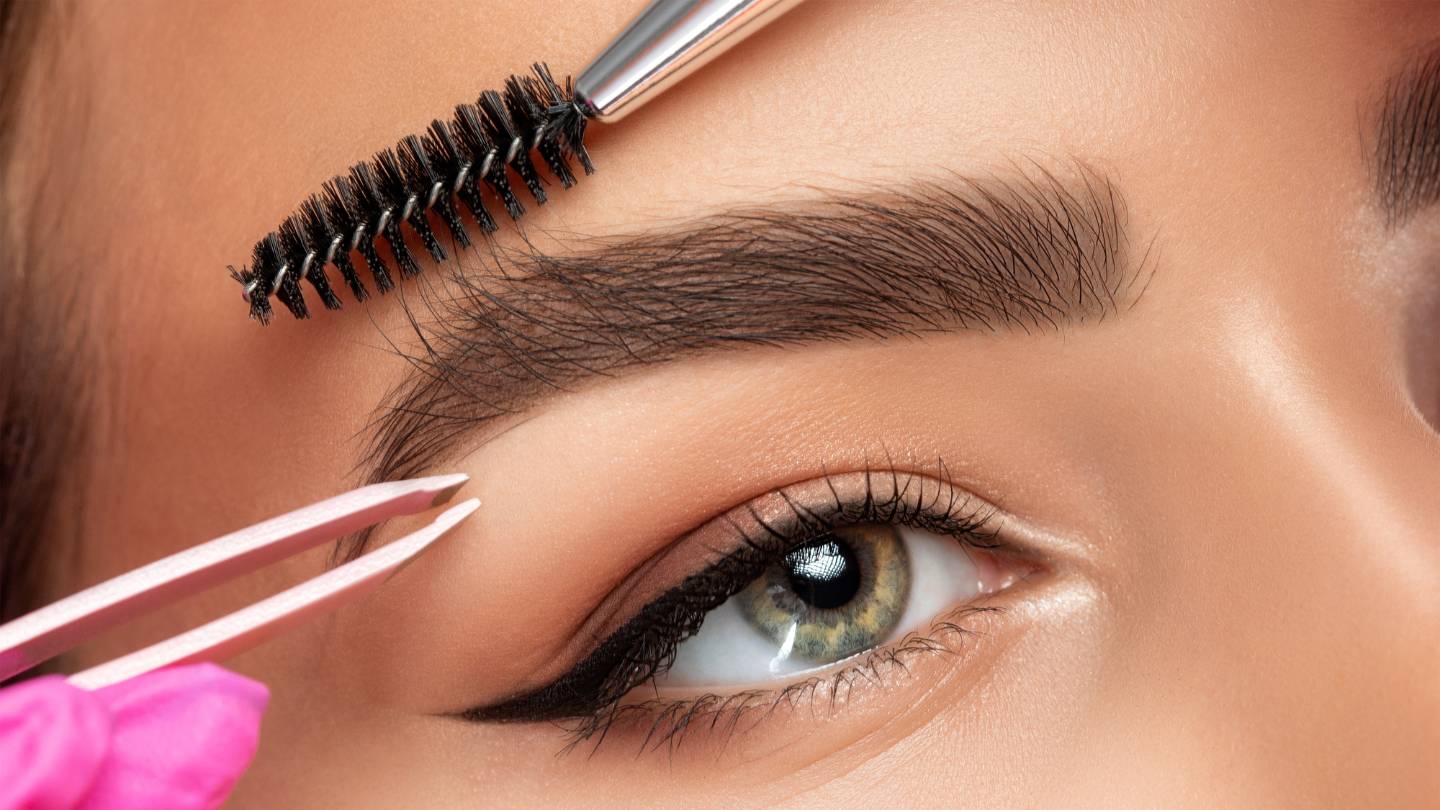Powder eyebrow tattooing, also known as ombre brows, is a semi-permanent makeup technique that provides a soft, powdered makeup look. Unlike traditional tattooing or microblading, this method offers a less invasive and more natural finish, ideal for those looking to enhance their brows with minimal upkeep.
The powder brow process involves several steps, each ensuring that the final result is symmetrical, natural, and tailored to your face. In this detailed guide, we’ll walk you through the process step-by-step, highlighting key points and advantages.
Let’s get straight to the point
Powder eyebrow tattooing, also known as ombre brows, is a semi-permanent makeup technique that creates a soft, natural-looking, and long-lasting brow effect. The process involves consultation, brow mapping, refining the shape, numbing the area, selecting the right pigment, and applying it with a machine to achieve a gradient or ombre look.
The result mimics the appearance of brow powder and is ideal for all skin types, offering less pain, low maintenance, and longevity of 1.5 to 2 years. Proper aftercare ensures the best results, making powder brows a versatile, low-maintenance beauty option.
The Step-By-Step Powder Brow Process
The powder brow process involves several key steps that ensure the final result is symmetrical, natural-looking, and tailored to your face shape and skin type. Here’s how it works:
Step 1: Consultation
The consultation is the foundation of a successful powder brow procedure. During this initial meeting, you’ll discuss the desired brow shape, thickness, and colour with your technician.
- Why it’s important: A thorough consultation ensures that the final result is personalised to suit your unique facial features and preferences.
- Technician’s role: They will assess your skin type and facial structure to determine the best brow style. For instance, oily skin types might require a different approach compared to dry skin types to ensure longevity.
Things to consider during your consultation:
- What brow shape best suits your face?
- What level of thickness or fullness do you want?
- Which colour will look most natural with your hair and skin tone?
After this, you’ll have a clear vision of what your brows will look like, setting the stage for a successful procedure.
Step 2: Brow Mapping
Once you and your technician have settled on your brow preferences, the next step is brow mapping. This process involves measuring your brows and facial features to create a perfectly symmetrical and balanced shape.
- Tools used: Brow mapping typically involves callipers, rulers, and sometimes digital tools to ensure accuracy.
- Why it’s important: Symmetry is key in eyebrow aesthetics. The technician will measure from the beginning to the arch and tail of the brow, ensuring both brows are even and proportional.
The brow mapping process includes the following:
- Measuring the starting point of the brow (aligned with the edge of your nostril).
- Defining the arch (typically 2/3 of the way across your brow).
- Marking the tail end (where your brow should naturally taper).
This precise measuring ensures that your brows will complement your facial structure and maintain a natural look.
Step 3: Refining The Brow Shape
With the basic brow map in place, the next step is refining the shape by tweezing or trimming any stray hairs. This helps create a clean canvas, which is essential for the pigment application that follows.
- Reviewing the shape: You’ll have a chance to review the brow shape before moving forward. This step is vital to ensure you’re completely satisfied before the tattooing begins.
- Importance of precision: The technician will pay close attention to the symmetry and proportion of the brows, making any necessary adjustments.
Tips for this stage:
- Don’t hesitate to speak up if you want minor changes to the shape.
- The final shape should enhance your natural features without looking overly dramatic or unnatural.
Step 4: Numbing Cream Application
Since powder brows involve tattooing pigment into the skin, a numbing cream is applied to minimise discomfort.
- How long it takes: The numbing cream typically takes 15-20 minutes to take effect.
- Why it matters: Although the procedure is less painful than traditional tattooing, the numbing cream helps ensure maximum comfort throughout the session. You may still feel a slight pressure or a tingling sensation, but it should be very manageable.
Key benefits of numbing cream:
- Ensures the procedure is as painless as possible.
- Helps those with lower pain tolerance feel more comfortable.
Step 5: Pigment Selection
Choosing the right pigment colour is critical to achieving a natural-looking result.
- Technician’s guidance: Your technician will help you choose a pigment shade that best matches your skin tone and hair colour.
- Why it’s essential: Using a pigment that is too dark can result in unnatural-looking brows, while a pigment that is too light may fade too quickly.
Factors to consider:
- Start with a lighter pigment: It’s easier to darken the colour during follow-up sessions if needed.
- Pigment should complement your natural features, providing a soft, realistic finish.
Step 6: Application Of Pigment Using A Machine
The actual tattooing process involves using a tattoo machine with a fine needle to apply tiny dots of pigment to the skin.
- How it works: The technician will layer the pigment in a gradual process, building up colour to achieve the desired look.
- Ombré effect: To create the signature powdered look, the technician will apply the pigment more lightly at the front of the brow and increase the density toward the tail, giving a gradient or ombré effect.
Process breakdown:
- Starting at the front of the brow with lighter shading.
- Gradually darkening toward the tail for a more defined look.
- Layering pigment to build colour.
This method ensures that the brows look soft and natural, resembling the effect of brow powder rather than solid lines.
Step 7: Layering And Adjustments
The technician may need to make several passes with the tattoo machine to achieve the perfect level of colour and shading.
- Importance of layering: This process is essential for building the ombré effect, where the front of the brows is lighter and the tail end is darker.
- Checking throughout the procedure: The technician will continuously check the shape and intensity of the pigment, making adjustments as needed.
Benefits of layering:
- Ensures a natural and dimensional look.
- Allows for more control over the final appearance.
Step 8: Optional Hair Strokes
In some cases, the technician may add microblading-like hair strokes to enhance the overall appearance of the brows.
- When it’s recommended: This step is usually suggested for clients with sparse natural brows or those who want to add more dimension to the powder effect.
- What it does: Adding hair strokes helps blend the powder with the look of individual hairs, creating a more realistic, multi-dimensional appearance.
Benefits Of Powder Eyebrow Tattooing
There are several reasons why individuals opt for powder brows over other forms of eyebrow enhancement. This method offers a range of benefits, making it an attractive option for many.
1. Natural Appearance
The soft, powdered finish of powder brows mimics the look of natural eyebrow makeup, providing a polished yet natural look. It’s ideal for those who want to fill in sparse areas without the harshness of traditional tattooing or microblading.
2. Long-Lasting Results
One of the major benefits of powder brows is their longevity. Unlike microblading, which may fade faster, powder brows typically last between 1.5 to 2 years. With minimal touch-ups, you can enjoy beautiful brows for an extended period.
3. Less Painful
Thanks to the use of numbing cream and the gentle nature of the shading technique, powder brows are generally less painful than traditional tattooing or microblading. Clients often report only feeling slight pressure or discomfort, making it a more comfortable experience overall.
4. Low Maintenance
Once your powder brows have healed, they require very little maintenance. You won’t need to fill in your brows daily, and touch-ups are usually only needed once a year.
This makes them an excellent option for those who prefer a low-maintenance beauty routine.
5. Suitable for All Skin Types
Unlike microblading, which may not be ideal for oily skin, powder brows are suitable for a wider range of skin types, including those with oily or sensitive skin. This versatility makes powder brows a great option for a broader audience.
Aftercare Tips
Proper aftercare is essential for ensuring the longevity and appearance of your powder brows. Here are some key aftercare tips:
- Avoid excessive moisture (e.g., sweating, swimming) for the first week.
- Use a recommended healing ointment to keep the area hydrated.
- Refrain from touching or scratching the brows as they heal.
- Follow any specific aftercare instructions provided by your technician.
By following these steps, you can ensure that your powder brows heal properly and maintain their shape and colour for as long as possible.
Conclusion
Powder eyebrow tattooing, or ombré brows, offers a versatile, long-lasting, and natural solution for those looking to enhance their eyebrows with minimal daily effort. This innovative technique ensures a soft, powdered finish that mimics the look of natural makeup while being suitable for all skin types, including oily or sensitive skin.
With its relatively painless application and durable results, powder brows provide an ideal option for individuals seeking a refined yet low-maintenance beauty routine. By following the outlined process and adhering to proper aftercare, you can enjoy beautifully defined brows that last for up to two years, enhancing your facial features and boosting your confidence effortlessly.
Whether you’re aiming for a subtle enhancement or a more defined look, powder brows offer the perfect blend of artistry and practicality.
FAQs About Powder Eyebrow Tattooing
What Is Powder Eyebrow Tattooing, And How Does It Differ From Other Eyebrow Tattoo Techniques?
Powder eyebrow tattooing, or powder brows or shading, is a semi-permanent makeup technique that creates a soft, powdered look on the eyebrows. It differs from techniques like microblading as it involves a shading effect rather than individual hair-like strokes. It’s an excellent choice for those looking for a more filled-in and defined brow appearance.
How Is Powder Eyebrow Tattooing Done?
Powder eyebrow tattooing is typically done using a machine or manual tool that deposits pigment into the skin in a stippling or tapping motion. The tattoo artist carefully builds up the colour and shape, layer by layer, until the desired density and definition are achieved. Depending on the client’s preferences and skin type, the process may take one or more sessions.
Who Is The Ideal Candidate For Powder Eyebrow Tattooing?
Powder eyebrow tattooing is suitable for a wide range of candidates, including those with sparse eyebrows, people looking to enhance their eyebrow shape and definition, and individuals with oily skin that may not be suitable for microblading. It’s also an excellent choice for anyone seeking a more filled-in and makeup-like appearance.
How Long Does The Powder Eyebrow Tattoo Last, And Does It Require Touch-Ups?
Depending on factors like skin type and aftercare, powder-eyebrow tattoos can last anywhere from 1 to 3 years. Touch-ups are recommended every 1 to 2 years to maintain the desired colour and shape. Regular touch-ups help keep your eyebrows looking fresh and defined.
Is There Any Downtime Or Aftercare Required After Getting A Powder Eyebrow Tattoo?
After getting a powder eyebrow tattoo, slight redness and swelling may occur, but this typically subsides within a few days. It’s essential to follow the aftercare instructions provided by your technician, which may include avoiding excessive moisture, sun exposure, and harsh skincare products during the healing process. Proper aftercare helps ensure the best results and longevity of your powder eyebrows.


